Conrad, Margrave of Meissen
| Conrad the Great | |
|---|---|
|
Conrad the Great in the Fürstenzug in Dresden | |
| Margrave of Meissen | |
| Reign | 1123–1156 |
| Predecessor | Wiprecht |
| Successor | Otto II |
| Margrave of Lusatia | |
| Reign | 1123–1156 |
| Predecessor | Henry III |
| Successor | Dietrich I |
| Born | c. 1097 |
| Died |
5 February 1157 Monastery of St Peter auf dem Lauterberg |
| Burial | Monastery of St Peter auf dem Lauterberg |
| Spouse | Luitgard of Elchingen-Ravenstein |
| Issue |
Otto II, Margrave of Meissen Theodoric I, Margrave of Lusatia Dedi III, Margrave of Lusatia Henry I, Count of Wettin Frederick I of Brehna Adela, Queen of Denmark Agnes II, Princess-Abbess of Quedlinburg |
| House | House of Wettin |
| Father | Thimo of Wettin |
| Mother | Ida of Nordheim |
Conrad the Great (c. 1097 – 5 February 1157) was the Margrave of Meissen from 1123 until his retirement in 1156. He was the son of Thimo, Count of Brehna, of the House of Wettin and Ida, daughter of Otto of Nordheim. He was also Count of Wettin, Brehna, and Camburg from before 1116.
In 1123, he became Count of Eilenburg. That same year, Lothair of Supplinburg, Duke of Saxony, appointed him Margrave of Meissen in opposition to Wiprecht von Groitzsch, the appointee of the Emperor Henry V. Lothair also named Albert the Bear Margrave of Lusatia, while Henry named Wiprecht to that march also. Wiprecht was unable to hold his own against his two opponents and in 1124 Conrad was securely in power in Meissen. In 1136, Lothair, then emperor, appointed him to Lusatia as well. Thereafter, Upper Lusatia remained a part of Meissen and the march of Lusatia was reduced to Lower Lusatia alone.
In 1143, Conrad became Count of Groitzsch and Rochlitz and Vogt of Chemnitz and Naumburg. In 1147, while Conrad III of Germany was away on the Second Crusade, Conrad the Great joined Henry the Lion, Adalbert of Salzwedel, Albert the Bear, and the Archbishops of Magdeburg and Bremen to organise a Crusade against the Obodrites and Wagri. In August, Conrad and Albert, with the bishops of Magdeburg, Havelburg, and Brandenburg, massed their forces at Magdeburg. The Obodrite prince Niklot and his fortresses of Dubin and Dimin were besieged. Both he and Pribislav, another Obodrite prince, were forced to accept Christianity and make peace.
In the following years, he founded the monastery of St Peter auf dem Lauterberg (Petersberg), to which he retired on 30 November 1156. He died and was buried there next to his wife, Luitgard (Lucarda) of Elchingen-Ravenstein, daughter of Adalbert, Count of Elchingen-Ravenstein and Bertha of Hohenstaufen, daughter of Frederick I, Duke of Swabia and Agnes of Germany.
Marriage and issue
Luitgard of Elchingen-Ravenstein, whom he had married before 1119, had blessed him with many children. His eldest surviving son, Otto II, Margrave of Meissen, succeeded him in Meissen, while his second surviving son, Dietrich I, succeeded in Lusatia. His son Henry I, Count of Wettin married Sophia of Sommerschenburg, Countess Palatine of Saxony, daughter of Count Fredrick II of Sommerschenburg and Countess Liutgard of Stade, queen dowager of Denmark.
His issue were:
- Heinrich (i.e. Henry; died young)
- Otto II
- Dietrich I
- Dedi III, Margrave of Lusatia
- Henry I, Count of Wettin, married (1) Sophia of Sommerschenburg (d. 1189 or 1190), daughter of Count Fredrick II of Sommerschenburg, Count Palatine of Saxony and his wife Countess Liutgard of Stade (later queen of Denmark).
- Frederick I of Brehna
- Oda
- Adela, Queen consort of Denmark
- Bertha
- Sophie
- Gertrud
- Agnes II, Princess-Abbess of Quedlinburg
Ancestry
| Ancestors of Conrad, Margrave of Meissen | ||||||||||||||||||||||||||||||||||||||||||||||||||||||||||||||||||||||||||||||||||||||||||||||||||||||||||||||||||||||||||||||||||||||||||||||||||||||||||||||||||||||||||||||||||||||||||||||||||||||||||||||||||||||||||||||||||||||||||||||||||||||||||||||||||||||||||||||||||||||||||||||||||||||||||||||||||||||||||||||||||||||||||||||||||||||||||||||||||||||||||||||||||||||||||||||||||||||||||||||||||||||||||||||||||||||||||||||||||||||||||||||||||||||||||||||||||||||
|---|---|---|---|---|---|---|---|---|---|---|---|---|---|---|---|---|---|---|---|---|---|---|---|---|---|---|---|---|---|---|---|---|---|---|---|---|---|---|---|---|---|---|---|---|---|---|---|---|---|---|---|---|---|---|---|---|---|---|---|---|---|---|---|---|---|---|---|---|---|---|---|---|---|---|---|---|---|---|---|---|---|---|---|---|---|---|---|---|---|---|---|---|---|---|---|---|---|---|---|---|---|---|---|---|---|---|---|---|---|---|---|---|---|---|---|---|---|---|---|---|---|---|---|---|---|---|---|---|---|---|---|---|---|---|---|---|---|---|---|---|---|---|---|---|---|---|---|---|---|---|---|---|---|---|---|---|---|---|---|---|---|---|---|---|---|---|---|---|---|---|---|---|---|---|---|---|---|---|---|---|---|---|---|---|---|---|---|---|---|---|---|---|---|---|---|---|---|---|---|---|---|---|---|---|---|---|---|---|---|---|---|---|---|---|---|---|---|---|---|---|---|---|---|---|---|---|---|---|---|---|---|---|---|---|---|---|---|---|---|---|---|---|---|---|---|---|---|---|---|---|---|---|---|---|---|---|---|---|---|---|---|---|---|---|---|---|---|---|---|---|---|---|---|---|---|---|---|---|---|---|---|---|---|---|---|---|---|---|---|---|---|---|---|---|---|---|---|---|---|---|---|---|---|---|---|---|---|---|---|---|---|---|---|---|---|---|---|---|---|---|---|---|---|---|---|---|---|---|---|---|---|---|---|---|---|---|---|---|---|---|---|---|---|---|---|---|---|---|---|---|---|---|---|---|---|---|---|---|---|---|---|---|---|---|---|---|---|---|---|---|---|---|---|---|---|---|---|---|---|---|---|---|---|---|---|---|---|---|---|---|---|---|---|---|---|---|---|---|---|---|---|---|---|---|---|---|---|---|---|---|---|---|---|---|---|---|---|---|---|---|---|---|---|---|---|---|---|---|---|---|---|---|---|---|---|---|---|---|---|---|---|---|---|---|---|---|---|---|---|---|---|---|---|---|---|---|---|---|---|---|---|---|---|---|---|---|---|---|---|---|
| ||||||||||||||||||||||||||||||||||||||||||||||||||||||||||||||||||||||||||||||||||||||||||||||||||||||||||||||||||||||||||||||||||||||||||||||||||||||||||||||||||||||||||||||||||||||||||||||||||||||||||||||||||||||||||||||||||||||||||||||||||||||||||||||||||||||||||||||||||||||||||||||||||||||||||||||||||||||||||||||||||||||||||||||||||||||||||||||||||||||||||||||||||||||||||||||||||||||||||||||||||||||||||||||||||||||||||||||||||||||||||||||||||||||||||||||||||||||
References
- Thompson, James Westfall. Feudal Germany, Volume II. New York: Frederick Ungar Publishing Co., 1928.
External links
| Wikimedia Commons has media related to Conrad, Margrave of Meissen. |
| Conrad the Great Born: c. 1097 Died: 5 February 1157 | ||
| Preceded by Wiprecht of Groitzsch |
Margrave of Meissen 1123–1156 |
Succeeded by Otto |
| Preceded by Henry of Groitzsch |
Margrave of Lusatia 1136–1156 |
Succeeded by Dietrich I |
